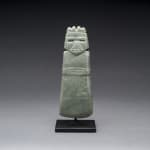Guanacaste-Nicoya Jade-Like Figure-Celt Pendant, 300 BCE - 500 CE
Jade-Like Stone
height 16.5 cm
height 6 1/2 in
height 6 1/2 in
PF.4060
In the context of Pre-Columbian art and archaeology, jade is a generic term that refers to any variety of hard, dense stones that were worked with great skill by native...
In the context of Pre-Columbian art and archaeology, jade is a generic term that refers to any variety of hard, dense stones that were worked with great skill by native artists. Although jade is generally thought to be green, it can actually be a range of colors. Jade carving flourished in ancient Costa Rica for over a thousand years, roughly from 500 B.C. to 900 A.D., although the period of greatest artistic accomplishment lasted from 300 to 700 A.D. It is believed that jade working began during an extended period of agricultural abundance that allowed the ancient society to dedicate part of its energies toward the cultivation of artistic pursuits.
Jade was considered to be a sacred material by the ancient populations of Costa Rica, held in even higher esteem than gold. Generally, it was thought to symbolize that vital life force that sustains us all. The color green is naturally associated with verdant plant life. Specifically, jade was thought to symbolize the sprouting maize plant, that staple of the Pre-Columbian diet. It has also been suggested that jade represents water. Either way, we can be certain that jade represented the very essence of life itself.
To date, no native sources of jade have been discovered in Costa Rica, suggesting an extended trade network existed that imported this precious resource from Mesoamerica into Costa Rica where it was carved by local artists. Such trade also would have brought great wealth and likely reinforced the social stratification of the peoples. Jade may have served as a status marker to distinguish the elite from the masses and solidify their hold on power. We can picture an ancient ruler or shaman presiding over a sacred ceremonial adorned in brilliant green jade pendants and jewelry. The ancient Costa Ricans believe that the system of social hierarchy also extended into the afterlife. Therefore, jade objects were buried with the elite so that their power could be maintained throughout eternity.
The anthropomorphic design of the figure-celt was greatly revered as a cult image primarily in Upper Central America, in the Guanacaste Region and in parts of the Atlantic Watershed. The cult image was probably derived from Olmec anthropomorphic Celts that were associated with earth, rain and thunderbolt. The stone Celt also had a long history in Mexico. The Celt is usually made from a hard, green stone either jade or jadeite, believed to have been imported in its raw state from Guatemala. Due to the durability of the stone, the skill required in carving such apiece is very great. The pale green stone allows the subtle carving of the hands and facial features to come alive within the stone. The angularity of the piece adds a distinct style and character, creating a mystery and wonder that transcends time and history of which we have become an integral part.
Jade was considered to be a sacred material by the ancient populations of Costa Rica, held in even higher esteem than gold. Generally, it was thought to symbolize that vital life force that sustains us all. The color green is naturally associated with verdant plant life. Specifically, jade was thought to symbolize the sprouting maize plant, that staple of the Pre-Columbian diet. It has also been suggested that jade represents water. Either way, we can be certain that jade represented the very essence of life itself.
To date, no native sources of jade have been discovered in Costa Rica, suggesting an extended trade network existed that imported this precious resource from Mesoamerica into Costa Rica where it was carved by local artists. Such trade also would have brought great wealth and likely reinforced the social stratification of the peoples. Jade may have served as a status marker to distinguish the elite from the masses and solidify their hold on power. We can picture an ancient ruler or shaman presiding over a sacred ceremonial adorned in brilliant green jade pendants and jewelry. The ancient Costa Ricans believe that the system of social hierarchy also extended into the afterlife. Therefore, jade objects were buried with the elite so that their power could be maintained throughout eternity.
The anthropomorphic design of the figure-celt was greatly revered as a cult image primarily in Upper Central America, in the Guanacaste Region and in parts of the Atlantic Watershed. The cult image was probably derived from Olmec anthropomorphic Celts that were associated with earth, rain and thunderbolt. The stone Celt also had a long history in Mexico. The Celt is usually made from a hard, green stone either jade or jadeite, believed to have been imported in its raw state from Guatemala. Due to the durability of the stone, the skill required in carving such apiece is very great. The pale green stone allows the subtle carving of the hands and facial features to come alive within the stone. The angularity of the piece adds a distinct style and character, creating a mystery and wonder that transcends time and history of which we have become an integral part.



